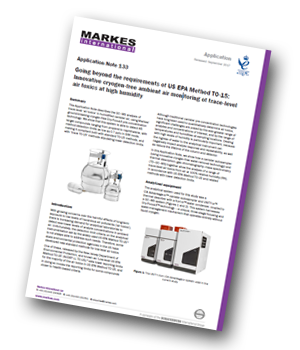Markes International has produced an application note describing how a canister autosampler (using innovative cryogen-free water-removal technology) and thermal desorption–gas chromatography–mass spectrometry (TD–GC–MS) together allow the analysis of a range of trace-level air toxics from air at 100% relative humidity (RH), in accordance with US EPA Method TO-15 and related methods with lower detection limits.

 Introduction
Introduction
With growing concerns over the harmful effects of long-term exposure to low levels of hazardous air pollutants (‘air toxics’), there is increasing demand for analytical laboratories to detect ever-lower levels of analyte concentrations in ambient air. Unfortunately, the detection limit criteria on the analytical instrumentation set by the widely used US EPA Method TO-15 is not always able to address such needs. Therefore, some
state environmental protection agencies in the US have developed new standard methods for low-level air toxics.
One of these, released by the New Jersey Department of Environmental Protection, and known as ‘Low-level US EPA Method TO-15’ (NJDEP LL TO-15), sets lower reporting limits for the majority of the air toxics in US EPA Method TO-15, and in doing so moves the reporting limits for some compounds closer to health-based criteria.
 Analytical Equipment
Analytical Equipment
The analytical system used for this study was a CIA Advantage-xr™ canister autosampler and UNITY-xr™ thermal desorber with a Kori-xr™ water condenser, coupled to a GC–MS system. This system harnesses Dry‑Focus3™ technology – a unique, three-stage focusing and water-management mechanism that operates entirely without liquid cryogen.
Conclusions
This system allows confident GC–MS of a wide range of analytes in humid air in accordance both with US EPA Method TO-15 and (due to its significantly increased sensitivity) with more stringent protocols such as the NJDEP LL TO-15 Method.
A key feature of the results is the excellent chromatographic performance for the analysis of a 65-component TO-15 mix (including polar and non-polar VOCs) at 100% RH, far exceeding all method requirements.




